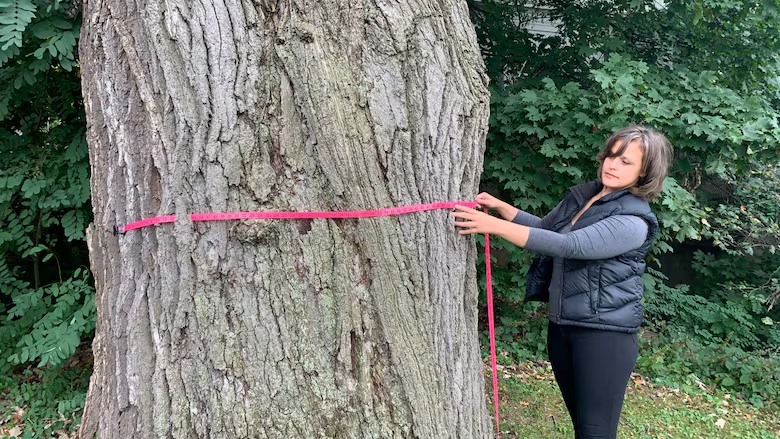Meet the woman searching for the oldest trees in Hamilton
Lesia Mokrycke plans to publish her findings in spring 2022

Lesia Mokrycke winds a measuring tape around an imposing bur oak tree. This massive, slow growing oak is isolated on a tiny piece of land next to St. Joseph's Hospital in downtown Hamilton.
"I think this tree is over 350 years old," she says using a mathematical formula involving the circumference of the tree to guess its age.
Mokrycke is a landscape architect and environmental artist from Hamilton. Three days a week she works for OMC Landscape Architecture here. The other two days a week she walks the streets of Hamilton documenting the oldest trees in the city. They have to be at least 150 years old to make the list.
Her project to list the old growth trees in Hamilton is funded by the Canada Council for the Arts. The tree list is just the ignition point for a project that blends science, social connections and art.
Her research also captures the stories people tell her when she is snooping about, eyes to the sky, tape measure in hand.
"It's teaching me how much people love old trees, how they feel a sense of ownership about them," she says.

She studies front-yard trees, and is invited in to backyards for viewing, often spontaneously. Many people take her to their favourite big trees in the neighbourhood. That's how she met the big bur oak on Mountwood Avenue.
"It's curious. It's surrounded by a chain link fence like someone is trying to protect it," Mokrycke says. "And the location, near the base of the escarpment, I'm sure the water flowing underground has helped it survive so long."
She continues to invite residents to alert her to trees of interest. With an artist's eye, she photographs each tree. Once she finishes her inventory, she plans to publish her findings in spring 2022, followed by an art exhibition.
Her stylish photos, which she is planning to blow up big and install outdoors, perhaps at the Royal Botanical Gardens (RBG), or Bayfront Park, would tell the story of Hamilton before it was a city, before it was carved up into a grid — a time when there was a true urban forest.
Mokrycke sees these trees, the bur oak by the hospital, the beech trees on Herkimer, a big bitternut hickory on Margaret Street, as anchors of what could be a holistic way to reforest the city.
"Trees are not competitive, they function better in communities, they work together," she says.
'We could build a green corridor'
The idea of protecting the city's oldest trees in a way that would foster new growth of saplings could also help in the quest to increase the urban tree canopy — something the city and organizations like Green Venture and Environment Hamilton are out to do.
To help those efforts, Mokrycke suggests old trees could be fenced off allowing the understory plants to grow in place of grass. This more natural habitat could be an incubator for new seedlings and new trees.
"We could build a green corridor through the city, with places for people to reconnect to the ecosystem."
At the RBG, Tys Theijsmeijer, head of natural areas, is slowly working on an inventory of big trees and vines in the city. He says Mokrycke's findings will add to the pool of valuable data.
"What she is doing is absolutely the best way to create discussion about the urban forest and tree canopy in Hamilton."
The old bur oak Theijsmeijer says has a lot to tell us about what landscape has been lost in the city.
Publishing her tree inventory and creating art work, Theijsmeijer says will "help more people imagine and value what the forests were once like here."
The city agrees the study could be valuable.
As Hamilton prepares to finalize its Urban Forest Strategy, Catherine Plosz, the city's natural heritage planner, says Mokrycke's tree inventory could provide needed information. "We don't have a heritage tree inventory or registry, it's just bits and pieces," Plosz says.
What trees tell us
Fragmentation has already disrupted green spaces in the city, Mokrycke says. It has created tree deserts and concrete corridors.
By identifying the most ancient trees in the city, Mokrycke hopes these "landmark trees" promote the planting of a community of trees. The concept could be introduced in schools, she says, with kids taking on the role of tree guardians.
Recent books and documentaries, such as The Hidden Life of Trees, explore how trees communicate with each other. As Mokrycke also points out, their roots hold information about major storms, pest invasions, and climate change. If ancient city trees aren't protected, the information is lost.
"Trees hold knowledge, they communicate threats to other trees. When they die or are cut down it's like a grandparent not being able to pass along knowledge."